国际幼儿园英语教学主任工作计划
幼稚园英语教学管理工作计划
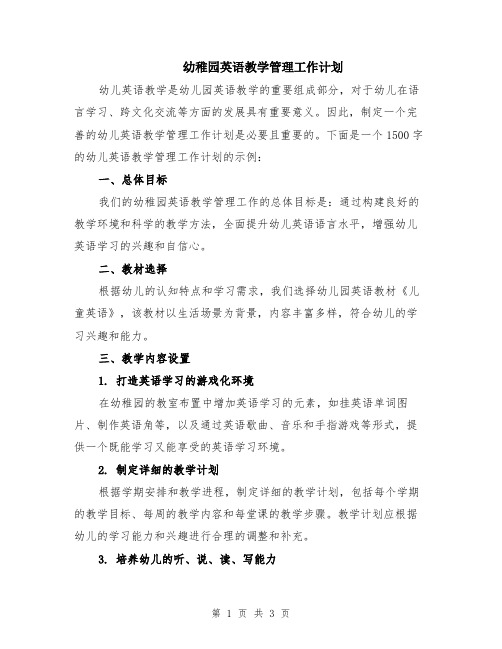
幼稚园英语教学管理工作计划幼儿英语教学是幼儿园英语教学的重要组成部分,对于幼儿在语言学习、跨文化交流等方面的发展具有重要意义。
因此,制定一个完善的幼儿英语教学管理工作计划是必要且重要的。
下面是一个1500字的幼儿英语教学管理工作计划的示例:一、总体目标我们的幼稚园英语教学管理工作的总体目标是:通过构建良好的教学环境和科学的教学方法,全面提升幼儿英语语言水平,增强幼儿英语学习的兴趣和自信心。
二、教材选择根据幼儿的认知特点和学习需求,我们选择幼儿园英语教材《儿童英语》,该教材以生活场景为背景,内容丰富多样,符合幼儿的学习兴趣和能力。
三、教学内容设置1. 打造英语学习的游戏化环境在幼稚园的教室布置中增加英语学习的元素,如挂英语单词图片、制作英语角等,以及通过英语歌曲、音乐和手指游戏等形式,提供一个既能学习又能享受的英语学习环境。
2. 制定详细的教学计划根据学期安排和教学进程,制定详细的教学计划,包括每个学期的教学目标、每周的教学内容和每堂课的教学步骤。
教学计划应根据幼儿的学习能力和兴趣进行合理的调整和补充。
3. 培养幼儿的听、说、读、写能力针对幼儿的语言发展特点,注重培养幼儿的听、说、读、写能力。
通过播放英语录音、教授常用英语口语表达、阅读英语绘本、进行英语歌谣和诗歌的学习,开展听、说的训练;通过教授英文字母、拼读单词、理解简单的英文句子、练习描红和点读练习等,开展读、写的训练。
4. 引导幼儿进行英语语言和文化的体验通过编排英语角色剧、观看英语动画片、参观英语国家传统文化展览等形式,引导幼儿深入了解英语国家的语言和文化,增加幼儿对英语语言的兴趣和认同感。
四、教学方法选择1. 情景教学法通过创设真实情境和角色扮演等方式,使幼儿在实际交流中学习英语,提高英语的应用能力。
2. 播放英语歌曲和儿歌利用音乐的力量培养幼儿的语感和节奏感,通过英语歌曲和儿歌的学唱,激发幼儿学习兴趣。
3. 情感教育以互动游戏和合作学习为手段,培养幼儿的合作意识和友善情感,提高学习效果。
幼儿园英文教师的工作计划

幼儿园英文教师的工作计划As a preschool English teacher, my job is to create a safe, nurturing, and stimulating learning environment for young children to develop their English language skills. I will work with children aged 3 to 6, helping them to build a strong foundation in English language and literacy through various activities and play-based learning.Key Responsibilities1. Design and Implement Lesson PlansI will create engaging and age-appropriate lesson plans that incorporate reading, writing, speaking, and listening activities. These plans will focus on developing vocabulary, phonics, and grammar skills in English. I will use a variety of teaching methods, such as story-telling, songs, games, and art activities, to keep the children engaged and excited about learning.2. Foster Language DevelopmentI will provide a supportive and encouraging environment for children to practice and develop their English language skills. I will engage them in conversations, help them learn new words, and encourage them to express themselves in English. I will use positive reinforcement and praise to build their confidence and motivate them to communicate more in English.3. Promote Literacy and ReadingI will introduce children to a wide range of English books and stories, and encourage them to explore and enjoy reading. I will read to them regularly and help them develop early literacy skills, such as letter recognition, phonemic awareness, and comprehension. I will also facilitate group discussions and activities related to the stories to enhance their understanding and appreciation of English literature.4. Support Social and Emotional DevelopmentI will create a caring and inclusive classroom environment where children feel valued and respected. I will help them build positive relationships with their peers and develop important social and emotional skills, such as sharing, taking turns, and resolving conflicts. I will also teach them about empathy and kindness through age-appropriate activities and discussions.5. Collaborate with Parents and ColleaguesI will communicate regularly with parents to provide updates on their child's progress and to offer suggestions for how they can support their child's English learning at home. I will also work closely with other teachers and staff to ensure a coordinated and cohesive approach to the children's overall development.Professional DevelopmentAs a professional educator, I am committed to ongoing learning and professional development. I will attend workshops, conferences, and training sessions to deepen my knowledge and skills in early childhood education and English language teaching. I will also seek feedback from colleagues and supervisors to continuously improve my teaching practice.ConclusionIn my role as a preschool English teacher, I am dedicated to fostering a love for the English language and helping young children develop the language skills they need to succeed in school and in life. I am passionate about creating a positive and enriching learning environment where every child can thrive and reach their full potential. I am excited to embark on this meaningful journey with my students and their families, and to make a positive impact in their lives.。
国际幼儿园一年工作计划
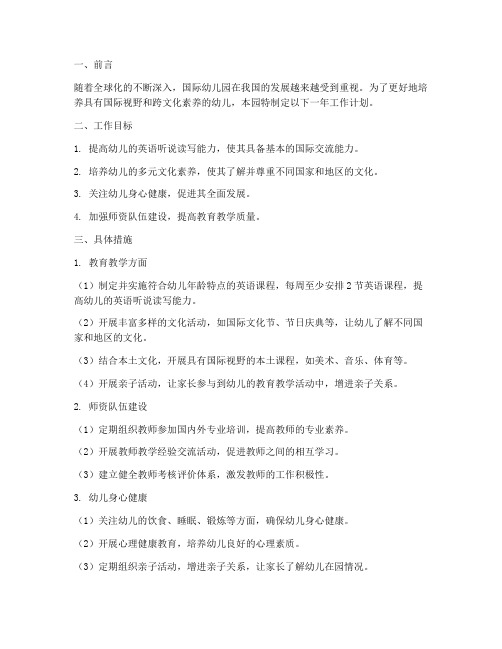
一、前言随着全球化的不断深入,国际幼儿园在我国的发展越来越受到重视。
为了更好地培养具有国际视野和跨文化素养的幼儿,本园特制定以下一年工作计划。
二、工作目标1. 提高幼儿的英语听说读写能力,使其具备基本的国际交流能力。
2. 培养幼儿的多元文化素养,使其了解并尊重不同国家和地区的文化。
3. 关注幼儿身心健康,促进其全面发展。
4. 加强师资队伍建设,提高教育教学质量。
三、具体措施1. 教育教学方面(1)制定并实施符合幼儿年龄特点的英语课程,每周至少安排2节英语课程,提高幼儿的英语听说读写能力。
(2)开展丰富多样的文化活动,如国际文化节、节日庆典等,让幼儿了解不同国家和地区的文化。
(3)结合本土文化,开展具有国际视野的本土课程,如美术、音乐、体育等。
(4)开展亲子活动,让家长参与到幼儿的教育教学活动中,增进亲子关系。
2. 师资队伍建设(1)定期组织教师参加国内外专业培训,提高教师的专业素养。
(2)开展教师教学经验交流活动,促进教师之间的相互学习。
(3)建立健全教师考核评价体系,激发教师的工作积极性。
3. 幼儿身心健康(1)关注幼儿的饮食、睡眠、锻炼等方面,确保幼儿身心健康。
(2)开展心理健康教育,培养幼儿良好的心理素质。
(3)定期组织亲子活动,增进亲子关系,让家长了解幼儿在园情况。
4. 家园合作(1)定期召开家长会,与家长沟通交流,共同关注幼儿成长。
(2)建立家园联系平台,方便家长了解幼儿园动态。
(3)开展亲子活动,增进家园之间的感情。
四、工作计划实施与评估1. 制定详细的工作计划,明确各阶段的目标和任务。
2. 定期对工作计划进行评估,及时调整工作方向。
3. 建立健全工作考核机制,确保工作计划顺利实施。
4. 加强与家长的沟通,及时了解家长需求和意见,不断改进工作。
五、结语本园将以一年工作计划为指导,努力提高教育教学质量,为幼儿提供优质的教育资源,培养具有国际视野和跨文化素养的下一代。
2024年国际幼儿园英语教学主任工作计划(2篇)

2024年国际幼儿园英语教学主任工作计划尊敬的领导:首先感谢贵园对我信任与支持,委任我为2024年国际幼儿园的英语教学主任。
我将竭尽全力履行这一重要职责,为贵园的英语教学质量和幼儿的综合素养发展贡献自己的力量。
一、整体工作目标1.提高幼儿园英语教学质量。
通过制定合理的教学目标,设计丰富多样的教学活动,培养幼儿的英语语言能力和跨文化交流能力。
2.加强师资队伍建设。
通过定期培训和交流,提高教师的英语教学能力和教育专业素养,激发教师的教学激情和创新能力。
3.加强与家长的沟通合作。
建立有效的家校沟通机制,与家长密切合作,共同关注和促进幼儿的学习和成长。
二、教学计划及安排1.制定教学目标。
根据国际幼儿园的教学大纲和学校的发展目标,制定每个学期的教学计划,确保教学内容的全面性和连贯性。
2.设计教学活动。
结合幼儿的年龄特点和英语学习需求,设计多样化的教学活动,包括游戏、歌曲、故事等,提供具有趣味性和启发性的学习环境。
3.推进教学改革。
鼓励教师运用多媒体和信息技术手段进行教学,积极探索适合幼儿园英语教学的新方法和新途径,提高教学效果和幼儿的学习兴趣。
4.评估与反馈。
建立科学有效的教学评估体系,及时反馈幼儿的学习情况和教师的教学效果,为教学改进提供依据。
三、师资队伍建设1.教师培训计划。
制定教师培训计划,安排定期的教学培训和学术交流活动,提高教师的教学能力和教育素养。
2.组织教研活动。
组织教师进行教学研讨、备课组织等活动,促进教师间的相互学习和经验分享,提高教师的专业素养和教学水平。
3.招聘与评价。
根据学校的发展需求和教师队伍建设的需要,参与招聘和评价工作,确保园内教师的素质和数量的匹配。
四、家校合作计划1.建立家校联系机制。
通过召开家长会、发布家校互动平台,与家长保持密切联系,及时了解幼儿的学习和成长情况。
2.举办亲子活动。
定期组织亲子活动,提供家长和幼儿的互动机会,共同探索幼儿学习的道路,并形成共同关注幼儿成长的良好氛围。
国际幼儿园英语教学主任工作计划
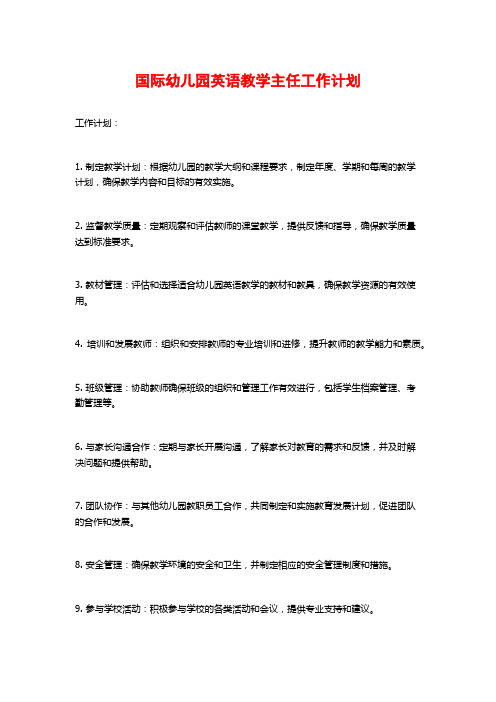
国际幼儿园英语教学主任工作计划
工作计划:
1. 制定教学计划:根据幼儿园的教学大纲和课程要求,制定年度、学期和每周的教学
计划,确保教学内容和目标的有效实施。
2. 监督教学质量:定期观察和评估教师的课堂教学,提供反馈和指导,确保教学质量
达到标准要求。
3. 教材管理:评估和选择适合幼儿园英语教学的教材和教具,确保教学资源的有效使用。
4. 培训和发展教师:组织和安排教师的专业培训和进修,提升教师的教学能力和素质。
5. 班级管理:协助教师确保班级的组织和管理工作有效进行,包括学生档案管理、考
勤管理等。
6. 与家长沟通合作:定期与家长开展沟通,了解家长对教育的需求和反馈,并及时解
决问题和提供帮助。
7. 团队协作:与其他幼儿园教职员工合作,共同制定和实施教育发展计划,促进团队
的合作和发展。
8. 安全管理:确保教学环境的安全和卫生,并制定相应的安全管理制度和措施。
9. 参与学校活动:积极参与学校的各类活动和会议,提供专业支持和建议。
10. 持续改进和评估:定期评估和反思工作,及时采取相关措施进行改进和提升。
以上是国际幼儿园英语教学主任的工作计划,旨在提供全面的教学管理和发展支持,确保幼儿园英语教学的顺利进行和提高教学质量。
幼儿园主任个人工作计划6篇

幼儿园主任个人工作计划6篇(经典版)编制人:__________________审核人:__________________审批人:__________________编制单位:__________________编制时间:____年____月____日序言下载提示:该文档是本店铺精心编制而成的,希望大家下载后,能够帮助大家解决实际问题。
文档下载后可定制修改,请根据实际需要进行调整和使用,谢谢!并且,本店铺为大家提供各种类型的经典范文,如工作汇报、工作报告、工作总结、工作计划、合同协议、条据书信、规章制度、教学资料、作文大全、其他范文等等,想了解不同范文格式和写法,敬请关注!Download tips: This document is carefully compiled by this editor. I hope that after you download it, it can help you solve practical problems. The document can be customized and modified after downloading, please adjust and use it according to actual needs, thank you!Moreover, our store provides various types of classic sample essays, such as work reports, work reports, work summaries, work plans, contract agreements, policy letters, rules and regulations, teaching materials, complete essays, and other sample essays. If you would like to learn about different sample formats and writing methods, please pay attention!幼儿园主任个人工作计划6篇工作计划可以帮助我们合理分配工作量,避免任务过度集中或过度分散,详细的工作计划可以让我们更好地掌握工作进展和完成情况,下面是本店铺为您分享的幼儿园主任个人工作计划6篇,感谢您的参阅。
幼儿园英语教师教学工作计划
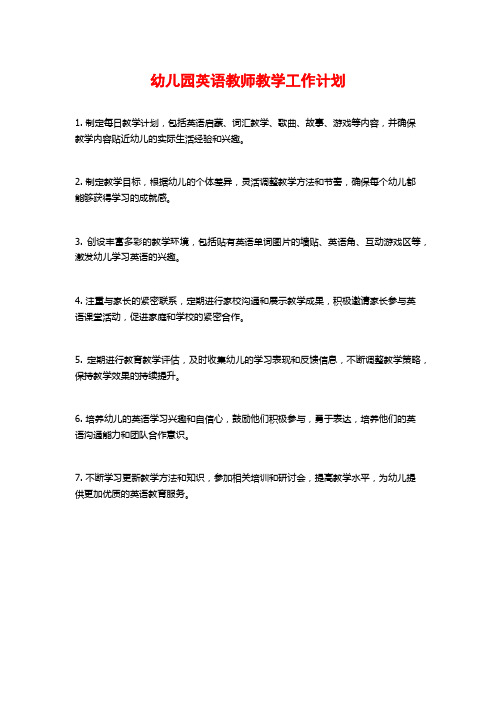
幼儿园英语教师教学工作计划
1. 制定每日教学计划,包括英语启蒙、词汇教学、歌曲、故事、游戏等内容,并确保
教学内容贴近幼儿的实际生活经验和兴趣。
2. 制定教学目标,根据幼儿的个体差异,灵活调整教学方法和节奏,确保每个幼儿都
能够获得学习的成就感。
3. 创设丰富多彩的教学环境,包括贴有英语单词图片的墙贴、英语角、互动游戏区等,激发幼儿学习英语的兴趣。
4. 注重与家长的紧密联系,定期进行家校沟通和展示教学成果,积极邀请家长参与英
语课堂活动,促进家庭和学校的紧密合作。
5. 定期进行教育教学评估,及时收集幼儿的学习表现和反馈信息,不断调整教学策略,保持教学效果的持续提升。
6. 培养幼儿的英语学习兴趣和自信心,鼓励他们积极参与,勇于表达,培养他们的英
语沟通能力和团队合作意识。
7. 不断学习更新教学方法和知识,参加相关培训和研讨会,提高教学水平,为幼儿提
供更加优质的英语教育服务。
幼儿园英文教师工作计划
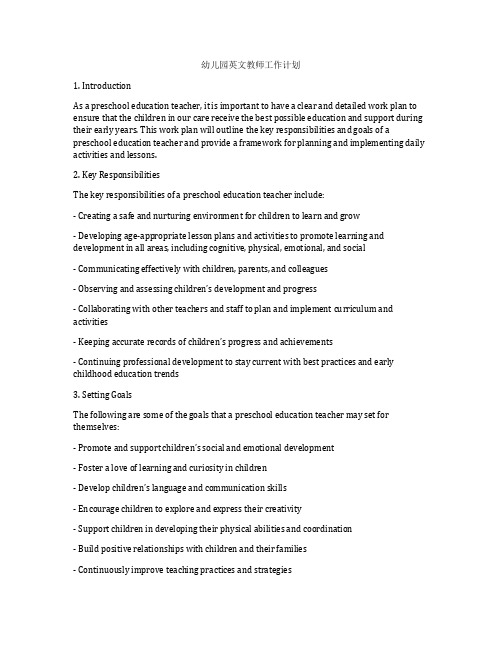
幼儿园英文教师工作计划1. IntroductionAs a preschool education teacher, it is important to have a clear and detailed work plan to ensure that the children in our care receive the best possible education and support during their early years. This work plan will outline the key responsibilities and goals of a preschool education teacher and provide a framework for planning and implementing daily activities and lessons.2. Key ResponsibilitiesThe key responsibilities of a preschool education teacher include:- Creating a safe and nurturing environment for children to learn and grow- Developing age-appropriate lesson plans and activities to promote learning and development in all areas, including cognitive, physical, emotional, and social- Communicating effectively with children, parents, and colleagues- Observing and assessing children’s development and progress- Collaborating with other teachers and staff to plan and implement curriculum and activities- Keeping accurate records of children’s progress and achie vements- Continuing professional development to stay current with best practices and early childhood education trends3. Setting GoalsThe following are some of the goals that a preschool education teacher may set for themselves:- Promote and support chi ldren’s social and emotional development- Foster a love of learning and curiosity in children- Develop children’s language and communication skills- Encourage children to explore and express their creativity- Support children in developing their physical abilities and coordination- Build positive relationships with children and their families- Continuously improve teaching practices and strategies4. Work PlanThe work plan for a preschool education teacher is dynamic and may change based on the needs and interests of the children, as well as the curriculum and program requirements. Here is a sample work plan for a week in a preschool classroom:MondayMorning:- Greet children and parents as they arrive- Lead circle time with songs, stories, and group activities- Introduce the theme of the week and discuss upcoming activities- Set up learning centers with activities related to the theme, such as art, sensory play, and dramatic play- Provide opportunities for children to engage in free play and exploration- Assist children in small group activities, such as puzzles or building blocks Afternoon:- Serve lunch and encourage children to practice self-help skills, such as using utensils and cleaning up- Lead outdoor play time and provide gross motor activities, such as running, jumping, and climbing- Read a book or sing quiet songs to help children wind down and prepare for rest time- Monitor and assist children during rest time, providing quiet activities for those who do not sleepTuesdayMorning:- Review the theme of the week and discuss the day’s activities- Lead a science experiment related to the theme, such as mixing colors or planting seeds - Facilitate a music and movement activity, such as a dance party or rhythm instruments - Help children engage in art activities, such as painting or collageAfternoon:- Serve snack and encourage children to practice manners and social skills during snack time- Lead outdoor play time with a focus on sensory experiences, such as sand or water play - Provide opportunities for drama and imaginative play with costumes and props- Read a story and discuss the day’s activities before dismissalWednesdayMorning:- Greet children and parents as they arrive- Lead circle time with songs, stories, and discussion of the day’s activities- Introduce a new math or literacy activity, such as counting or letter recognition- Provide small group activities focused on fine motor skills, such as cutting or tracing Afternoon:- Serve lunch and encourage children to make healthy choices and try new foods- Lead outdoor play time with a focus on cooperative games and teamwork- Provide a special activity, such as a science demonstration or a guest speaker- Read a book or sing songs to help children transition to rest timeThursdayMorning:- Review the theme of the week and discuss the day’s activities- Lead a nature walk or scavenger hunt to explore the outdoor environment- Engage children in dramatic and imaginative play, such as a pretend restaurant or doctor’s office- Provide opportunities for art and sensory play, such as playdough or watercolors Afternoon:- Serve snack and facilitate a discussion on healthy eating habits and nutrition- Lead outdoor play time with a focus on teamwork and cooperation in group games- Provide opportunities for children to engage in quiet activities, such as puzzles or books- Review the day’s activities and encourage reflection before dismissalFridayMorning:- Greet children and parents and review the week’s activities- L ead a special project or activity related to the week’s theme, such as a cooking activity or a group art project- Provide opportunities for children to engage in free play and exploration- Assist children in small group activities, such as puzzles or building blocks Afternoon:- Serve snack and facilitate a discussion of the week’s activities and achievements- Lead outdoor play time with a focus on free play and exploration- Provide opportunities for children to express themselves through music and movement - Review the week’s activities and encourage children to share their favorite moments before dismissal5. ConclusionA preschool education teacher plays a crucial role in promoting the development and well-being of young children. By creating a safe and nurturing environment, developing age-appropriate activities and lessons, and fostering positive relationships with children and their families, a preschool education teacher can help lay the foundation for lifelong learning and success. This work plan provides a framework for planning and implementing daily activities and lessons that support the growth and development of young children in a preschool setting.。
2023年国际幼儿园英语教学主任工作计划

2023年国际幼儿园英语教学主任工作计划引言作为国际幼儿园的英语教学主任,我将致力于提供高质量的教育,促进学生的英语语言发展和全面发展。
本文将重点介绍2023年我的工作计划。
一、教学目标和方法1. 确定教学目标:根据国际幼儿园的教学计划和每个学生的发展阶段,制定符合他们个体需求和特点的教学目标。
2. 教学方法:使用多样化的教学方法,例如游戏、音乐、绘本和戏剧等,激发学生的兴趣和参与度。
二、课程设计和教材选择1. 课程设计:根据学生的英语水平和年龄特点,设计有趣而富有挑战性的课程,使他们能够在听、说、读、写各方面有所提高,并培养他们的创新思维和解决问题的能力。
2. 教材选择:选择适合学生年龄和英语水平的教材,如英语绘本、教育电视节目和英语游戏等,以提高学生对英语学习的兴趣。
三、教学评估和反馈1. 教学评估:定期进行学生的英语水平评估,了解他们的学习进展和需要改进的地方,并根据评估结果调整教学策略和课程设计。
2. 反馈机制:与学生的家长保持及时沟通,定期向他们反馈学生的学习情况和表现,并与他们讨论如何共同支持学生的学习发展。
四、师资培训和团队合作1. 师资培训:组织定期培训和研讨会,以提高教师的教学能力和专业素养,关注最新的教育研究和教学方法,以及跟进国际幼儿园的最新要求和标准。
2. 团队合作:鼓励教师之间的合作和共享教学经验,建立共同的教学理念和教学方法,并提供相应的支持和资源。
五、家长和社会联系1. 家长沟通:定期组织家长会议,并与家长交流学生的学习情况和教育目标,以及如何在家里支持孩子的英语学习。
2. 社会联系:与当地社区和其他学校建立联系,参加和组织一些与英语学习相关的活动,如英语角或英语比赛,以提供更多学习机会和促进英语环境的建设。
六、自我提升和专业发展1. 自我提升:定期参加教育研讨会和国际教育展览,了解最新的教育趋势和学术发展,不断提高自己的专业知识和技能。
2. 专业发展:积极参与国内外专业组织和学术交流活动,分享自己的教学经验和教学研究成果,提高自己的学术水平和专业声誉。
幼儿园英语工作计划
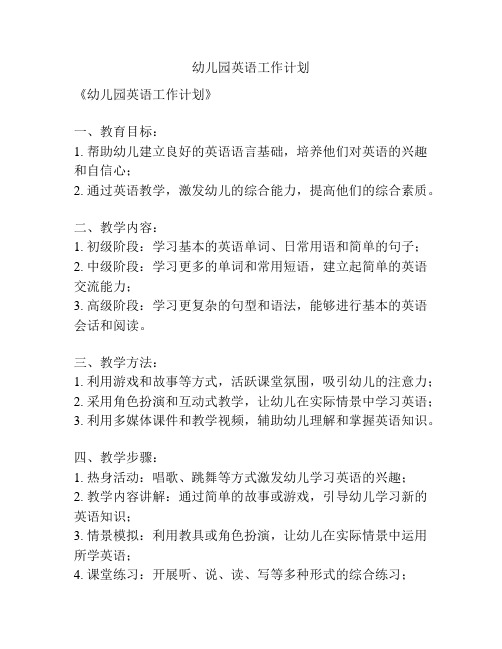
幼儿园英语工作计划《幼儿园英语工作计划》一、教育目标:1. 帮助幼儿建立良好的英语语言基础,培养他们对英语的兴趣和自信心;2. 通过英语教学,激发幼儿的综合能力,提高他们的综合素质。
二、教学内容:1. 初级阶段:学习基本的英语单词、日常用语和简单的句子;2. 中级阶段:学习更多的单词和常用短语,建立起简单的英语交流能力;3. 高级阶段:学习更复杂的句型和语法,能够进行基本的英语会话和阅读。
三、教学方法:1. 利用游戏和故事等方式,活跃课堂氛围,吸引幼儿的注意力;2. 采用角色扮演和互动式教学,让幼儿在实际情景中学习英语;3. 利用多媒体课件和教学视频,辅助幼儿理解和掌握英语知识。
四、教学步骤:1. 热身活动:唱歌、跳舞等方式激发幼儿学习英语的兴趣;2. 教学内容讲解:通过简单的故事或游戏,引导幼儿学习新的英语知识;3. 情景模拟:利用教具或角色扮演,让幼儿在实际情景中运用所学英语;4. 课堂练习:开展听、说、读、写等多种形式的综合练习;5. 课堂总结:对本节课的学习内容进行总结和回顾。
五、教学评估:1. 观察幼儿在课堂上的学习表现和参与度;2. 进行口头测试和书面作业,检查幼儿的学习成果;3. 定期组织英语韵律表演或英语角活动,检验幼儿的英语语言实际运用能力。
六、工作计划:1. 制定每周的英语教学计划,确保教学内容和进度的合理安排;2. 配备相应的教学资料和教具,提供有效的辅助教学;3. 定期举办家长会或教学展示活动,让家长了解幼儿的英语学习情况;4. 不断学习和提高自身的教学水平,不断改进教学方法和课程内容。
通过以上的工作计划,我们将努力为幼儿提供良好的英语学习环境,让他们在快乐的氛围中轻松学习英语,逐步掌握英语的基本知识和技能。
希望通过我们的努力,幼儿们都能够在英语学习中有所收获,展现出自己的潜能和才华。
幼儿英文教师工作计划

幼儿英文教师工作计划Introduction:As a preschool English teacher, my primary goal is to create a nurturing and stimulating learning environment for young children. I am committed to fostering a love for learning and helping my students develop their language skills, social skills, and creativity. This work plan outlines my goals, strategies, and activities for the upcoming academic year.Goals:1. To create a welcoming and inclusive classroom environment where every child feels valued and supported.2. To develop age-appropriate English language skills in listening, speaking, reading, and writing.3. To encourage creativity and critical thinking through engaging and hands-on learning activities.4. To promote social and emotional development by teaching important values such as kindness, empathy, and cooperation.5. To build strong partnerships with parents and caregivers to support children's learning and development at home.Strategies:1. Creating a classroom environment that is visually appealing, comfortable, and safe.2. Using a variety of teaching methods, including music, movement, storytelling, and arts and crafts, to cater to different learning styles.3. Incorporating play-based learning activities to make learning fun and meaningful for young children.4. Implementing positive behavior management techniques to create a respectful and harmonious classroom atmosphere.5. Communicating regularly with parents through newsletters, parent-teacher meetings, and workshops.Activities:1. Circle Time: Engage students in singing songs, playing games, and discussing daily topics to build language skills and promote social interaction.2. Storytelling: Use picture books, puppet shows, and role-playing activities to enhance students' listening and speaking skills while fostering a love for literature.3. Art and Craft: Provide opportunities for children to express themselves creatively through painting, drawing, and other art activities.4. Learning Centers: Set up different play areas, such as a dramatic play area, a science area, and a sensory play area, to encourage hands-on learning and exploration.5. Parent Workshops: Hold regular workshops on various topics, such as early literacy, positive discipline, and bilingual education, to support parents in their role as their child's first teacher.Assessment:1. Conduct ongoing observations and informal assessments to monitor students' progress in language development, social skills, and academic readiness.2. Use portfolios and checklists to document students' achievements and track their individual growth.3. Hold parent-teacher conferences to discuss each child's strengths and areas for growth, and to set goals for their continued development.Professional Development:1. Attend workshops, seminars, and conferences to stay updated on the latest research and best practices in early childhood education.2. Collaborate with colleagues to share ideas and resources, and to participate in peer observations and reflective discussions.3. Pursue further education and training to enhance my teaching skills and knowledge in areas such as child development, language acquisition, and special needs education. Conclusion:As a preschool English teacher, I am dedicated to providing a high-quality learning experience for young children. Through careful planning, creative teaching strategies, and ongoing assessment, I aim to empower my students and help them build a strong foundation for future academic success. I look forward to the upcoming year and the opportunity to make a positive impact on the lives of the children in my care.。
幼儿园英语教师工作计划标准范文(4篇)
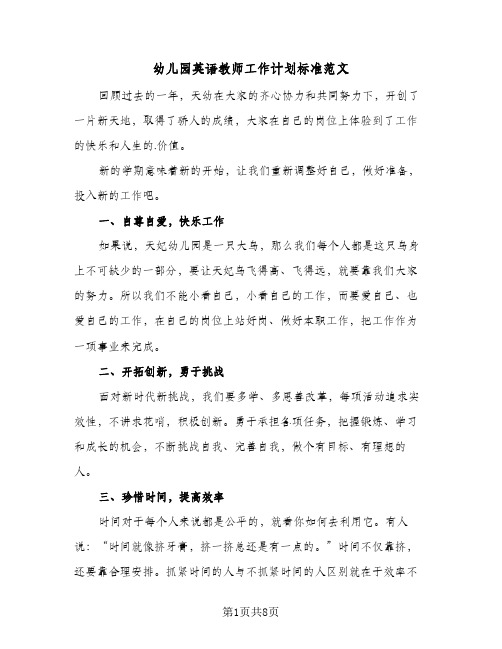
幼儿园英语教师工作计划标准范文回顾过去的一年,天幼在大家的齐心协力和共同努力下,开创了一片新天地,取得了骄人的成绩,大家在自己的岗位上体验到了工作的快乐和人生的.价值。
新的学期意味着新的开始,让我们重新调整好自己,做好准备,投入新的工作吧。
一、自尊自爱,快乐工作如果说,天妃幼儿园是一只大鸟,那么我们每个人都是这只鸟身上不可缺少的一部分,要让天妃鸟飞得高、飞得远,就要靠我们大家的努力。
所以我们不能小看自己,小看自己的工作,而要爱自己、也爱自己的工作,在自己的岗位上站好岗、做好本职工作,把工作作为一项事业来完成。
二、开拓创新,勇于挑战面对新时代新挑战,我们要多学、多思善改革,每项活动追求实效性,不讲求花哨,积极创新。
勇于承担各项任务,把握锻炼、学习和成长的机会,不断挑战自我、完善自我,做个有目标、有理想的人。
三、珍惜时间,提高效率时间对于每个人来说都是公平的,就看你如何去利用它。
有人说:“时间就像挤牙膏,挤一挤总还是有一点的。
”时间不仅靠挤,还要靠合理安排。
抓紧时间的人与不抓紧时间的人区别就在于效率不同,如何提高工作效率,用好每一分每一秒是我们应该去思考的问题。
不要让一天天无所事事地过去,而要让每一天都过得精彩。
幼儿园英语教师工作计划标准范文(二)一、情况分析二、教学模式根据我班幼儿的特点,创建以游戏活动为主的教学模式,组织和设计生动活泼的英语游戏活动,让幼儿在活动中学,在游戏中学,在玩玩乐乐、不知不觉中轻松地自然习得英语。
树立以孩子为主体的教学观和欣赏教育观。
采取“热身/复习-情景呈现-交际性游戏-唱歌/歌谣”的教学模式,即在上课前先调动幼儿的情绪、兴趣和积极性,复习所学过的内容,以旧带新;在情景中介绍新单词、句型和对话;引导幼儿进行模拟性交际游戏或交际性游戏活动,在活动中学习英语;学唱英语歌曲和歌谣,边唱边跳,通过歌曲和歌谣巩固所学的句型,培养幼儿自主学习英语的良好习惯。
三、学期目标1、让幼儿对英语产生学习兴趣,愿意参加英语活动。
幼儿园英语工作计划 (2)

幼儿园英语工作计划一、教学目标设定幼儿园阶段的英语教学,应以培养孩子们的语言感知能力和兴趣为主,注重听说训练,为将来的英语学习打下坚实的基础。
具体教学目标如下:激发幼儿对英语的兴趣和好奇心,培养其主动学习英语的意愿。
提高幼儿的英语听力水平,能够听懂简单的日常用语和指令。
培养幼儿的英语口语表达能力,鼓励其大胆开口说英语。
拓展幼儿的英语词汇量,学习并掌握一些基本的生活用语。
培养幼儿基本的英语语感,通过音乐、儿歌、故事等形式感知英语韵律。
二、教学内容规划根据教学目标,我们规划了以下教学内容:基础词汇:教授幼儿常见的动物、食物、颜色、数字等基础词汇。
日常用语:教授简单的问候、道谢、道歉、请求等日常用语。
指令性语言:教授幼儿基本的课堂指令、生活指令等。
儿歌与歌曲:教授一些简单易学的英语儿歌和歌曲,培养幼儿的语感和节奏感。
故事讲述:通过简单的英语故事,激发幼儿的兴趣和想象力。
三、教学方法选择针对幼儿园孩子的特点,我们选择了以下教学方法:游戏化教学:通过游戏的形式,使幼儿在游戏中学习英语,寓教于乐。
互动式教学:鼓励幼儿积极参与,通过师幼互动、幼幼互动来提高学习效果。
情境化教学:创设真实的英语情境,让幼儿在情境中学习和运用英语。
音乐与律动:通过音乐和律动来教授英语,增强幼儿的记忆力和语感。
四、教学资源准备为了确保教学的顺利进行,我们准备了以下教学资源:教材与教具:选择适合幼儿园孩子的英语教材和教具,如卡片、挂图、绘本等。
多媒体设备:利用电视、投影仪等多媒体设备播放英语儿歌、动画片等教学资源。
英语角:设立英语角,提供英语图书、玩具等,供幼儿自由探索和游戏。
外籍教师:聘请外籍教师参与教学,提供纯正的英语发音和语言环境。
五、教学进度安排我们将按照以下进度安排进行教学:第1-2周:进行基础词汇和日常用语的教授,重点培养幼儿的听力理解能力。
第3-4周:加强英语口语训练,教授简单的指令性语言,鼓励幼儿大胆开口说英语。
第5-6周:教授英语儿歌和歌曲,培养幼儿的语感和节奏感。
2023年国际幼儿园英语教学主任工作计划范文

2023年国际幼儿园英语教学主任工作计划范文一、背景介绍2023年国际幼儿园是一所专注于提供全英文教学的幼儿园。
作为英语教学主任,我的责任是确保教学质量的提高,提供儿童全面发展的学习环境和教育资源。
在这个工作计划中,将重点关注以下几个方面:课程设计与实施、教师培训与发展、家长合作与沟通和评估与反馈。
二、课程设计与实施1. 制定年度教学计划:根据幼儿的年龄特点和发展需要,制定全年的教学计划,包括课程主题、教学目标、教学资源和评估方式等。
2. 制定教案:为教师提供详细的教案,包括教学活动、教学方法、教具使用等,确保教学内容的有效传达和教学质量的提高。
3. 督导课堂教学:定期观摩和评估教师的课堂教学,提供指导和反馈,促进教师的专业成长和教学水平的提升。
4. 与教师合作开发教材:与教师团队合作,开发符合幼儿发展需求的英语教材和教具,提供多样化的教学资源。
三、教师培训与发展1. 制定培训计划:根据教师的需求和专业发展方向,制定年度培训计划,包括内部培训、外部培训和专业学习等。
2. 组织专业培训活动:安排专业培训师进行内部培训,邀请国内外专家进行外部培训,提高教师的教学能力和专业素养。
3. 提供反馈和指导:定期与教师进行个别面谈,听取教师的需求和困惑,并提供反馈和指导,帮助教师解决问题和改善教学质量。
四、家长合作与沟通1. 家校互动活动:定期举办家长会、亲子活动和展览等,提供家长与教师的互动机会,增进双方的了解和信任。
2. 家长培训:为家长提供相关的培训和教育资源,帮助家长更好地支持孩子的学习和成长。
3. 家长沟通渠道:建立双向沟通的平台,定期向家长传达学校教育理念和教学进展,同时倾听家长的意见和建议,持续改善教育质量。
五、评估与反馈1. 学生评估:制定多种评估工具和方法,对学生的学习成果和发展进行定期评估,及时发现问题并采取相应的教学措施。
2. 教师评估:建立全面的教师评估体系,包括教学观摩评估、教学案例评估和学生反馈评估等,为教师的职业发展提供参考和支持。
国际幼儿园英语教学主任工作计划文档3篇
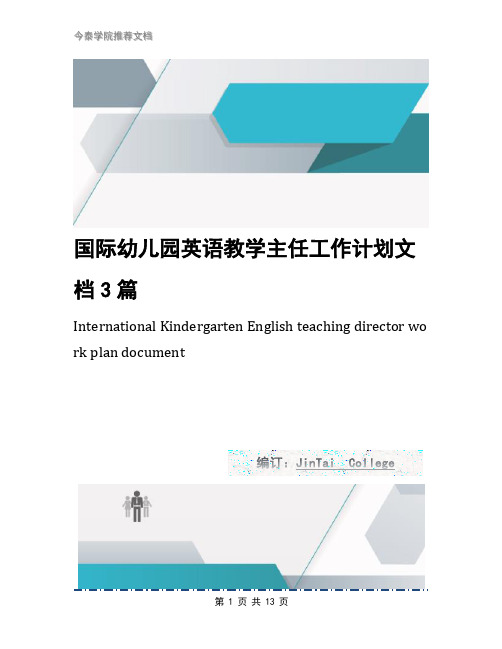
国际幼儿园英语教学主任工作计划文档3篇International Kindergarten English teaching director wo rk plan document国际幼儿园英语教学主任工作计划文档3篇小泰温馨提示:工作计划是对一定时期的工作预先作出安排和打算时制定工作计划,有了工作计划,工作就有了明确的目标和具体的步骤,大家协调行动,使工作有条不紊地进行。
工作计划对工作既有指导作用,又有推动作用,是提高工作效率的重要手段。
本文档根据工作计划的书写内容要求,带有规划性、设想性、计划性、方案和安排的特点展开说明,具有实践指导意义。
便于学习和使用,本文下载后内容可随意修改调整修改及打印。
本文简要目录如下:【下载该文档后使用Word打开,按住键盘Ctrl键且鼠标单击目录内容即可跳转到对应篇章】1、篇章1:幼儿园英语教学工作计划文档2、篇章2:幼儿园英语教学工作计划文档3、篇章3:幼儿园英语教学工作计划文档学好英语,从幼儿园开始,那么幼儿园英语教学主任如何制定工作计划?下面是小泰收集整理的幼儿园英语教学工作计划,欢迎阅读。
篇章1:幼儿园英语教学工作计划文档我班幼儿学习英语的兴趣较大,有3个小朋友已参加过童遥音乐英语的学习,还有一不费部分幼儿有英语基础,能用英语问早、掌握小部分的英语单词。
由于我班男孩子较多,大部分幼儿都属于“好动型”,故幼儿学习的活动气氛比较活跃。
但由于小班幼儿的发音器官和听觉发饮并不十分完善,还不能辨别差别较小的音,不善于协调使用发音方法,所以存在发音不清楚的情况。
如把“thank you”读成“fank you”,把“ here ”读成“kere”等。
根据我班幼儿的特点,创建以游戏活动为主的教学模式,组织和设计生动活泼的英语游戏活动,让幼儿在活动中学,在游戏中学,在玩玩乐乐、不知不觉中轻松地自然习得英语。
树立以孩子为主体的教学观和欣赏教育观。
采取“热身/复习——情景呈现——交际性游戏——唱歌/歌谣”的教学模式,即在上课前先调动幼儿的情绪、兴趣和积极性,复习所学过的内容,以旧带新;在情景中介绍新单词、句型和对话;引导幼儿进行模拟性交际游戏或交际性游戏活动,在活动中学习英语;学唱英语歌曲和歌谣,边唱边跳,通过歌曲和歌谣巩固所学的句型,培养幼儿自主学习英语的良好习惯。
幼儿园英文教师的工作计划

幼儿园英文教师的工作计划IntroductionAs a preschool English teacher, my main goal is to create a fun and educational environment where children can learn and grow. My work plan is designed to ensure that I provide a comprehensive English language learning experience for my young students. This plan incorporates a variety of activities, curriculum topics, and teaching methods to engage children in the learning process and help them develop their English language skills.Weekly Work PlanMonday:- Morning circle time: Introduce the letter of the week and its sound, review vocabulary words, and sing songs related to the theme of the week.- Storytime: Read a children's book related to the letter of the week, and encourage students to identify the letter and its sound throughout the story.- Fine motor skills activity: Practice writing the letter of the week and draw pictures of words that start with that letter.- Outdoor play: Encourage students to use English while playing with their peers.Tuesday:- Phonics lesson: Introduce new phonics rules and practice reading and writing words that contain the letter of the week.- Arts and crafts: Create art projects that relate to the letter of the week, such as coloring pictures of objects that start with that letter.- Music and movement: Dance and sing along to English songs that reinforce vocabulary and phonics skills.- Math activity: Incorporate English into counting and number recognition exercises.Wednesday:- Language development: Play interactive games that encourage students to use English to communicate and express themselves.- Science exploration: Engage students in simple science experiments and discussions while using English vocabulary.- Dramatic play: Set up a play area with props related to the letter of the week and encourage students to use English to pretend and role-play.- Outdoor play: Organize a nature walk and use English to describe the things they see and hear in the environment.Thursday:- Writing practice: Guide students in writing simple sentences that incorporate words with the letter of the week.- Social studies lesson: Introduce cultural topics and discuss traditions and customs from different English-speaking countries.- Sensory play: Engage students in sensory activities while using English to describe the textures, smells, and colors they experience.- Outdoor play: Encourage students to engage in physical activities while using English to communicate with their peers.Friday:- Show and tell: Have students bring in an item that starts with the letter of the week and describe it in English to their classmates.- Cooking activity: Prepare a simple recipe with the students and use English to discuss the ingredients and cooking process.- Group discussion: Engage students in a discussion about their favorite activities and use English to talk about their preferences.- Outdoor play: Allow students to participate in free play while using English to interact and communicate with each other.Monthly Work PlanWeek 1:- Introduce the alphabet and letter recognition activities.- Begin teaching basic vocabulary words related to everyday objects and activities.- Incorporate songs and rhymes into daily routines to reinforce vocabulary and phonics skills.Week 2:- Introduce simple sight words and begin practicing reading and writing with these words. - Engage students in interactive storytelling and role-playing activities to encourage language development.- Begin practicing basic sentence structures and introduce grammar concepts using simple activities and exercises.Week 3:- Expand on vocabulary topics related to different themes, such as animals, colors, and shapes.- Introduce basic writing skills, including letter formation and sentence structure.- Encourage students to engage in more complex language activities, such as group discussions and debates.Week 4:- Review and reinforce language skills learned throughout the month.- Incorporate more advanced phonics and reading activities to challenge students' language abilities.- Organize a language and cultural awareness day where students can showcase their language skills and learn about different English-speaking countries and traditions. Yearly Work Plan- Develop a comprehensive curriculum that covers a range of language skills, including reading, writing, speaking, and listening.- Plan and execute themed units that integrate language learning with other subjects, such as math, science, and social studies.- Organize parent-teacher conferences to discuss students' progress and share strategies for supporting English language development at home.- Collaborate with colleagues to create a cohesive and integrated English language learning program for the entire preschool.ConclusionAs a preschool English teacher, it's important to create a well-rounded and engaging curriculum that meets the unique needs of young learners. By incorporating a variety of activities, themes, and teaching methods into my work plan, I will be able to provide a comprehensive English language learning experience for my students. This work plan will help me stay organized, focused, and committed to fostering a positive and enriching learning environment for the children in my care.。
幼儿园英文教师工作计划
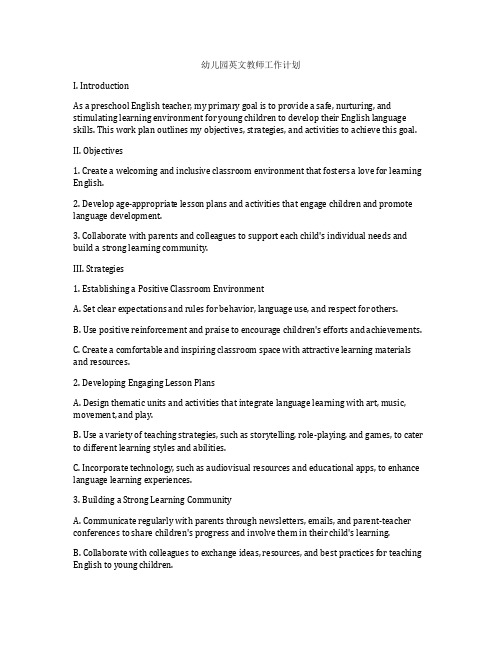
幼儿园英文教师工作计划I. IntroductionAs a preschool English teacher, my primary goal is to provide a safe, nurturing, and stimulating learning environment for young children to develop their English language skills. This work plan outlines my objectives, strategies, and activities to achieve this goal.II. Objectives1. Create a welcoming and inclusive classroom environment that fosters a love for learning English.2. Develop age-appropriate lesson plans and activities that engage children and promote language development.3. Collaborate with parents and colleagues to support each child's individual needs and build a strong learning community.III. Strategies1. Establishing a Positive Classroom EnvironmentA. Set clear expectations and rules for behavior, language use, and respect for others.B. Use positive reinforcement and praise to encourage children's efforts and achievements.C. Create a comfortable and inspiring classroom space with attractive learning materials and resources.2. Developing Engaging Lesson PlansA. Design thematic units and activities that integrate language learning with art, music, movement, and play.B. Use a variety of teaching strategies, such as storytelling, role-playing, and games, to cater to different learning styles and abilities.C. Incorporate technology, such as audiovisual resources and educational apps, to enhance language learning experiences.3. Building a Strong Learning CommunityA. Communicate regularly with parents through newsletters, emails, and parent-teacher conferences to share children's progress and involve them in their child's learning.B. Collaborate with colleagues to exchange ideas, resources, and best practices for teaching English to young children.C. Organize special events and activities, such as family literacy nights and multicultural celebrations, to create a sense of belonging and unity among families and children.IV. Activities1. Establishing a Positive Classroom EnvironmentA. Set up a classroom library with a variety of English books, including picture books, storybooks, and poetry.B. Create a cozy reading corner with cushions and bean bags where children can enjoy quiet reading time.C. Display children's artwork and writing samples on the walls to showcase their creativity and language skills.2. Developing Engaging Lesson PlansA. Plan a "Safari Adventure" unit where children learn about animals and nature through English stories, songs, and hands-on activities.B. Organize a "Cooking Day" where children follow simple English recipes to make snacks and learn new vocabulary related to food and cooking.C. Introduce a "Mystery Box" game where children use clues and descriptive language to guess the hidden objects inside the box.3. Building a Strong Learning CommunityA. Host a "Literacy Night" event for parents and children to engage in fun English language activities, such as storytelling, puppet shows, and book swaps.B. Participate in professional development workshops and conferences to network with other educators and stay updated on best practices for teaching English to young children.C. Coordinate a "Cultural Fair" where families share their traditions, languages, and cuisines to celebrate diversity and promote understanding among children and parents.V. Evaluation and Reflection1. Monitor children's language development through regular observations, assessments, and portfolios of their work.2. Seek feedback from parents, colleagues, and children to evaluate the success of teaching strategies and activities.3. Reflect on my teaching practice and make adjustments to improve the quality of English language learning experiences for young children.In conclusion, this work plan outlines the essential components of my role as a preschool English teacher, from creating a positive classroom environment to developing engaging lesson plans and building a strong learning community. By implementing these strategies and activities, I aim to provide young children with a solid foundation in English language skills and a lifelong love for learning.。
幼儿园英文部工作计划
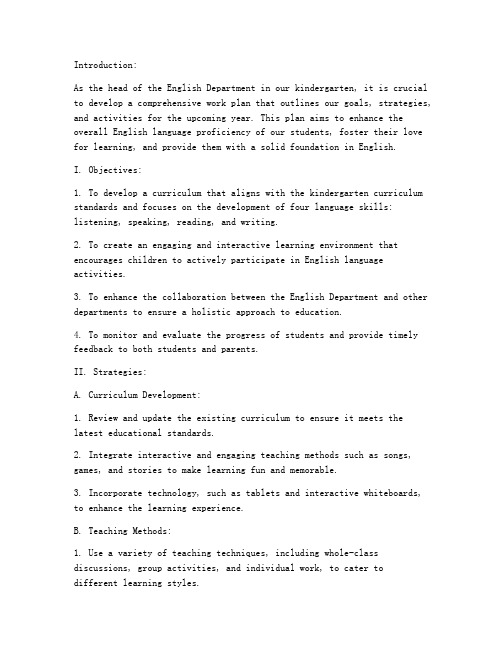
Introduction:As the head of the English Department in our kindergarten, it is crucial to develop a comprehensive work plan that outlines our goals, strategies, and activities for the upcoming year. This plan aims to enhance the overall English language proficiency of our students, foster their love for learning, and provide them with a solid foundation in English.I. Objectives:1. To develop a curriculum that aligns with the kindergarten curriculum standards and focuses on the development of four language skills: listening, speaking, reading, and writing.2. To create an engaging and interactive learning environment that encourages children to actively participate in English language activities.3. To enhance the collaboration between the English Department and other departments to ensure a holistic approach to education.4. To monitor and evaluate the progress of students and provide timely feedback to both students and parents.II. Strategies:A. Curriculum Development:1. Review and update the existing curriculum to ensure it meets thelatest educational standards.2. Integrate interactive and engaging teaching methods such as songs, games, and stories to make learning fun and memorable.3. Incorporate technology, such as tablets and interactive whiteboards, to enhance the learning experience.B. Teaching Methods:1. Use a variety of teaching techniques, including whole-class discussions, group activities, and individual work, to cater todifferent learning styles.2. Encourage students to speak and listen actively by incorporatingrole-playing, storytelling, and discussions into daily lessons.3. Provide opportunities for students to practice their reading and writing skills through interactive activities and exercises.C. Collaboration:1. Work closely with other departments, such as the Music and Art Departments, to integrate English language learning with other subjects.2. Collaborate with parents to provide them with resources and support to help their children learn English at home.3. Organize joint events, such as cultural festivals, to promote cross-cultural understanding and appreciation.D. Monitoring and Evaluation:1. Conduct regular assessments to monitor the progress of students and identify their strengths and weaknesses.2. Provide individualized feedback to students and parents to help them understand their children's performance and areas for improvement.3. Review and adjust the curriculum and teaching methods based on the assessment results to ensure continuous improvement.III. Activities:A. Daily Lessons:1. Conduct engaging and interactive lessons that focus on the development of language skills.2. Introduce new vocabulary and phrases relevant to the students' age and level.3. Provide opportunities for students to practice their speaking and listening skills through group activities and pair work.B. Extracurricular Activities:1. Organize regular English corners, where students can practice their English in a relaxed and friendly environment.2. Arrange cultural events, such as Halloween and Christmas celebrations, to expose students to different cultures and languages.3. Collaborate with local English-speaking organizations to arrangeguest speakers and cultural exchange programs.C. Parental Involvement:1. Conduct regular parent-teacher meetings to discuss students' progress and provide guidance on how parents can support their children's learning.2. Distribute monthly newsletters to keep parents informed about the curriculum and upcoming events.3. Encourage parents to participate in school activities and events to foster a strong sense of community.Conclusion:The English Department of our kindergarten is committed to providing our students with a high-quality English language education. By implementing this work plan, we aim to create an engaging and supportive learning environment that will help our students develop strong language skills and a love for learning. With the cooperation and support of our colleagues, students, and parents, we are confident that we will achieve our goals and contribute to the overall success of our kindergarten.。
幼儿园英文教师工作计划

幼儿园英文教师工作计划Kindergarten English Teacher Work PlanIntroduction:Being an English teacher in a kindergarten is a fulfilling and challenging role. Working with young learners requires creativity, patience, and a comprehensive understanding of child development. This work plan aims to outline the responsibilities and activities that a kindergarten English teacher should engage in to ensure effective language learning for the children.I. Curriculum Design and Implementation:A. Prepare an age-appropriate English language curriculum that aligns with the kindergarten’s overall goals and objectives.B. Create lesson plans that include various interactive activities such as songs, games, and storytelling to engage the children.C. Integrate language skills, such as listening, speaking, reading, and writing, into the curriculum.D. Continually assess the effectiveness of the curriculum and make necessary adjustments to meet the needs of the children.E. Coordinate with other teachers to ensure a smooth transition between classes and to reinforce English language learning throughout the school day.II. Classroom Management:A. Establish a positive and inclusive classroom environment that encourages active participation and cooperation among students.B. Implement behavior management strategies to promote discipline and respect within the classroom.C. Provide clear instructions and routines to ensure smoothtransitions between activities.D. Foster a sense of community by organizing collaborative projects and group activities.E. Create a print-rich classroom environment with labels, word walls, and visual aids to support vocabulary development.III. Assessing and Monitoring Child Progress:A. Conduct regular assessments to monitor each child's English language development.B. Use a variety of assessment tools, such as observation, checklists, and portfolios, to gather evidence of learning.C. Keep detailed records of each child's progress and share this information with parents during parent-teacher conferences or through progress reports.D. Use assessment data to identify areas of strength and weakness in the curriculum and adapt teaching strategies accordingly.E. Collaborate with other teachers and specialists to provide tailored support for children with special educational needs or those who are struggling with English language acquisition.IV. Parent Communication and Involvement:A. Establish open lines of communication with parents and provide regular updates on their child's progress and classroom activities.B. Organize parent workshops or events that empower parents to support their child’s English language learning at home.C. Encourage parental involvement in the classroom through volunteer opportunities, guest speaking, or special events.D. Respond promptly to parental concerns or questions and actively seek their feedback on the English language program.E. Collaborate with parents to develop strategies for smoothtransitions between home and school environments.V. Professional Development:A. Stay updated on the latest teaching methodologies, materials, and resources for teaching English to young learners.B. Attend workshops, conferences, and webinars to enhance professional knowledge and skills.C. Collaborate and share best practices with fellow teachers and participate in professional learning communities.D. Seek feedback from school administration, colleagues, and parents to continuously improve teaching practices.E. Reflect on personal teaching experiences and set professional goals to enhance teaching effectiveness.Conclusion:Being an English teacher in a kindergarten requires dedication, expertise, and a deep understanding of the needs of young learners. This work plan serves as a guide to ensure that teachers can effectively develop and implement an engaging English language program while nurturing a supportive classroom environment for children's holistic development. By continuously assessing and adapting teaching strategies, communicating with parents, and engaging in professional development, teachers can create a positive and impactful learning experience for the children.。
幼稚园英语教学管理工作计划

幼稚园英语教学管理工作计划
教学管理工作计划是为了确保幼稚园英语教学工作的顺利开展而制定的一项重要计划。
以下是一个幼稚园英语教学管理工作计划的范例:
1. 制定教学目标和计划:根据幼儿英语教学要求和学科标准,制定适合幼儿发展需求
的教学目标和课程计划。
确保每个学期的教学内容有足够的覆盖面,同时注重培养幼
儿的英语听说读写能力。
2. 教材教具准备:评估教学资源,选择适合幼儿学习的教材和教具。
确保教材内容的
连贯性和适应性,以及教具的质量和安全性。
3. 师资培训:组织英语教师参加相关培训和研讨会,提升他们的教学能力和专业水平。
定期进行教师教学观摩和互动交流,促进教师间的合作和学习。
4. 课堂管理:制定并贯彻有效的课堂管理规则,以维持良好的教学秩序和学习氛围。
鼓励幼儿积极参与课堂活动,培养他们的自主学习和合作意识。
5. 评估和反馈:定期进行教学评估,了解幼儿的学习情况和进展。
根据评估结果,及
时调整教学内容和方法,提供个性化的学习指导和反馈。
6. 家长沟通:与家长保持良好的沟通和合作,及时向家长传达幼儿的学习情况和表现。
定期组织家长会和亲子活动,加强家校合作,共同关注幼儿的全面发展。
7. 教学质量监控:建立教学质量监控机制,定期对教学管理工作进行评估和反馈。
搜
集并分析幼儿、家长和教师的意见和建议,及时改进教学管理方式和方法。
这个工作计划可以作为幼稚园英语教学管理工作的参考,根据具体情况进行调整和完善。
通过有效的教学管理,可以确保幼儿英语教学工作的高效进行,促进幼儿的全面发展。
- 1、下载文档前请自行甄别文档内容的完整性,平台不提供额外的编辑、内容补充、找答案等附加服务。
- 2、"仅部分预览"的文档,不可在线预览部分如存在完整性等问题,可反馈申请退款(可完整预览的文档不适用该条件!)。
- 3、如文档侵犯您的权益,请联系客服反馈,我们会尽快为您处理(人工客服工作时间:9:00-18:30)。
国际幼儿园英语教学主任工作计划幼儿园英语教学工作计划篇一一、情况分析我班幼儿学习英语的兴趣较大,有3个小朋友已参加过童遥音乐英语的学习,还有一不费部分幼儿有英语基础,能用英语问早、掌握小部分的英语单词。
由于我班男孩子较多,大部分幼儿都属于“好动型”,故幼儿学习的活动气氛比较活跃。
但由于小班幼儿的发音器官和听觉发饮并不十分完善,还不能辨别差别较小的音,不善于协调使用发音方法,所以存在发音不清楚的情况。
如把“thank you”读成“fank you”,把“ here ”读成“kere”等。
二、教学模式根据我班幼儿的特点,创建以游戏活动为主的教学模式,组织和设计生动活泼的英语游戏活动,让幼儿在活动中学,在游戏中学,在玩玩乐乐、不知不觉中轻松地自然习得英语。
树立以孩子为主体的教学观和欣赏教育观。
采取“热身/复习——情景呈现——交际性游戏——唱歌/歌谣”的教学模式,即在上课前先调动幼儿的情绪、兴趣和积极性,复习所学过的内容,以旧带新;在情景中介绍新单词、句型和对话;引导幼儿进行模拟性交际游戏或交际性游戏活动,在活动中学习英语;学唱英语歌曲和歌谣,边唱边跳,通过歌曲和歌谣巩固所学的句型,培养幼儿自主学习英语的良好习惯。
三、学期目标1、让幼儿对英语产生学习兴趣,愿意参加英语活动。
2、听懂教师用英语发出与日常生活有关的简单指令,并能用动作做出反应。
3、能记住自己的英文名字,能说出同伴的英文名字。
4、准确地学会一些简单单词和短语的发音,如常见的动物和水果的英语名称。
5、学会一些有趣的英语歌曲、儿歌,提高幼儿听说兴趣。
6、锻炼幼儿能在日常生活中大胆地用英语进行简单交流。
四、教学内容教材《现代儿童英语》是结合幼儿园整合课程,精选幼儿喜爱的单词、对话、歌曲、游戏及句型,作为教学内容,采用tpr和快乐教学法,通过丰富的肢体语言和充满激情的教学,让幼儿在快乐有节奏的爵士音乐声中动静结合,培养幼儿听力、语感、口语表达能力以及自信心。
除了本书的内容,我班还将根据本班幼儿特点,学习一些其他课外的英语歌曲和英语童谣。
幼儿园英语教学工作计划篇二学前班共有学生人数29人。
这个阶段的孩子刚刚离开幼儿园比较松散的环境,对于学校生活还不完全适应,学生上课时的控制能力差和思想注意力不集中,且部分学生刚接触学习英语,对英语学习没有基础,因此教学难度很大。
一、基本情况学前班共有学生人数29人。
这个阶段的孩子刚刚离开幼儿园比较松散的环境,对于学校生活还不完全适应,学生上课时的控制能力差和思想注意力不集中,且部分学生刚接触学习英语,对英语学习没有基础,因此教学难度很大。
少数学生在幼儿园学过一点,但大部分学生没有接触过英语,所以在今后的教学中,应面向全体生,激发学生学习英语的兴趣,充分调动他们的自主能动性、积极性,并发挥团队协作精神,营造互帮互助,共同学习英语的语境。
二、教材分析学前班英语教学以国家《幼儿园教育指导纲要》为根本,秉承了“赏识、创意、体验、伙伴”的少年儿童社会教育理念。
教材充分考虑到幼儿身心发展的规律和学习特点,特别设计了培养幼儿多元智能、关注幼儿生活经验的英语教学活动,不仅实现了幼儿阶段英语兴趣的培养和语感的启蒙,更实现了与小学英语教育的自然衔接和过渡。
以三个主人公的成长故事为主线,贯穿幼儿情商教育和道德品质培养。
以快乐的小小派乐多游行队为主题形式,营造轻松有趣的学习氛围。
以培养多元智能的主题式情境教学为依托,实践体验与发现、创意与欣赏的教学理念。
以完全互动的立体教育教学方案为载体,实现了家园共育和学习型家庭的构建。
以独具匠心的绘画和动画设计为表现形式,培养小朋友的想象力和初步的感受美、欣赏美的情趣与能力。
三、教学目的要求教材从小朋友的学习兴趣、生活经验和认知规律出发,针对学习习惯与策略、思维技能与发展的培养,设计了以学生为中心、师生互动、亲子互动的开发多元智能的主题式情境教学活动,使语言学习和小朋友的实际生活自然融合,既激发了小朋友学习英语的兴趣和热情,又培养了小朋友注意倾听、勇于表达的习惯,更为小朋友创造了用英语进行自我展示的空间与机会。
学前班的孩子应能达到的课程目的要求为:对英语有好奇心,喜欢听他人说英语。
能根据教师的简单指令做游戏、做动作、做事情(如涂颜色、连线)。
能做简单的角色扮演。
能唱简单的英文歌曲,说简单的英语歌谣。
能在图片的帮助下听懂和读懂简单的小故事。
能交流简单的个人信息,表达简单的情感和感觉。
能对英语学习中接触的外国文化习俗感兴趣。
四、教学措施1、更新教育观念,明确教师角色,建立以人为本的学生主体观,建立民主、平等、和谐、合作的教育观,让学生在轻松的氛围中学到知识。
2、通过歌曲、游戏、歌谣、游戏、制作等活动巩固所学内容培养学生对英语学习的兴趣。
让课堂焕发出生命的活力,在课堂上,有讲有练,精讲精练,有动有静,让学生说起来,动起来。
3、实行开放式教学方式,让每个学生在参与交流中提高英语交际水平,同时提高学习兴趣和合作能力。
4、训练和提高学生能听懂一些日常生活对话,能用英语进行简单交流。
五、教学模式根据我班幼儿的特点,创建以游戏活动为主的教学模式,组织生动活泼的英语游戏活动,让幼儿在活动中学,在游戏中学,在不知不觉中快乐的学习英语。
六、教学进度(略)幼儿园英语教学工作计划篇三一、明确幼儿英语教学活动目标首先,明确幼儿英语学习的目标,不是为了习得高水平的英语专业知识,体现庞大的词汇量,而是通过英语这一语言教学。
一方面培养幼儿学习的兴趣及对英语语音的敏感性,为以后的英语学习打好扎实的基础;而另一方面则通过语言发展幼儿的交往能力及培养科学的语言习得技巧,初步形成对多元文化的理解和尊重。
其次,幼儿英语教学活动目标要明确,便于理解和操作。
当英语活动游戏化时,目标的明确一定是以要实现的教学目的为依据,不可宽泛、概括、难操作。
如培养英语口语能力等等。
最后,为了使幼儿能在教学中更多的体验到游戏的乐趣,目标对于幼儿应是隐蔽的,但在教师心中却是清楚的。
当游戏与教学相结合时,游戏与教学的目标要一致。
游戏作为教学的辅助手段必须为教学服务,二者相匹配。
二、选择的教学内容应是幼儿感兴趣的幼儿阶段的认识往往是无意识多于有意识,幼儿所获得的知识经验很多是在日常生活和游戏活动中无意识地、自然而然地记住的。
英语教学内容应根据幼儿年龄及身心发展特点,在不超出或者接受能力范围内进行,选择他们所熟悉的基本内容。
三、注重游戏化的英语教学活动结构游戏化的幼儿英语教学活动的设计与组织是为实现教育目标,以游戏为幼儿的主要活动形式,对教育内容的具体展开和教育方式、方法的具体运用。
要根据幼儿的发展需要、生活经验、年龄特点和他们的兴趣爱好,组织设计生动活泼的活动,创造良好的语言环境和轻松愉快的学习气氛,让幼儿在活动中学,在游戏中学,在环境中学。
游戏化的幼儿英语教学活动的基本结构一般分成3个层次,它是一个由感知---理解---运用---发展的认知过程。
这样的设计体现了斯金纳提倡的小步递进程序。
目的在于使学习者容易完成,每完成一步都能得到积极的强化,并体验到自己是在向着一个特定的目标前进并享受着这种进步的快乐。
第一层次,创设语境,教师展示新授内容。
语言的使用离不开特定的语言情景。
创设语境是活动设计中极为重要的一环。
所谓语境,即语句的上下文。
心理语言学家的研究表明,幼儿的理解力在很大程度上依赖于环境,局限于此时此地的具体事务,幼儿的记忆也依赖于环境。
创设语境,既是帮助幼儿正确理解语言含义的重要依据,也是消除紧张,激发幼儿交际欲望,鼓励幼儿积极参与的有效方法,更是培养幼儿在语言环境中准确得体地使用英语进行焦急的必由之路。
因此,在设计组织时,应首先考虑创设尽可能真实有趣的情景。
第一层次的活动设计和组织的关键是通过情景创设,帮助幼儿在特定的语境中整体感知、理解语言材料,激发强烈的交际需要和参与欲望,为下一步的模仿操练做好准备。
第二层次,模拟操练,帮助幼儿消化所学内容。
英语教学主要是培养幼儿的语言实践能力。
不经反复的模仿操练,幼儿不可能掌握语言,没有大量的听说实践,也不可能达到熟练的运用。
此时,一般侧重于机械训练,确保幼儿能有足够的语言实践量,使新知识的感知及理解鲜明、完整、深刻。
但是,游戏能让幼儿避免枯燥乏味的单纯训练,它可以使幼儿在富于变化、生动有趣的一系列游戏活动中逐步熟悉并习得单词。
如紧接上一层活动的小游戏喜欢的花Ilike the red(yellowink…)flower,听到教师指令,幼儿则躲藏到某种颜色的花朵后面,待幼儿熟悉规则后,可请幼儿发指令,用这样的游戏来巩固。
第三层次,运用扩展,引导幼儿巩固和发展已学知识。
让幼儿初步掌握的内容得到及时的巩固、整理和运用。
如What color is it?这个活动到了此环节,可通过游戏种花 Let s plan,将幼儿分成三组,自由在花园图上种上自己喜欢的花,边种边说出花的颜色。
三个层次的游戏层层递进地帮助幼儿学习巩固---整理单词,让幼儿在游戏中学习和玩耍。
四、灵活掌握有效的教学游戏方法1.字母字母好比构建英语高楼的砖瓦,掌握了准确的发音和排列顺序,就意味着为今后的学习打下了坚实的基础。
学习字母时可以运用以下游戏帮助幼儿掌握:(1)外型模仿游戏。
幼儿用手指在空中书写字母掌握字母的特征,在用身体动作模仿字母的外型特征,然后在拍照和我做动作你猜字母的游戏中巩固。
(2)口型游戏。
在教授字母的发音时,教师的发音细节可以酌情夸张,做到字正腔洋。
看口型猜字母这个游戏可以帮助幼儿复习字母的读音。
例如,教师作出字母A的口型,但不发音,幼儿通过观察模仿教师的口型就可以猜出是A。
这样,不仅帮助幼儿掌握了字母正确发音和口型,而且还培养了幼儿细致的观察能力以及快速反映能力。
(3)排序游戏。
帮助幼儿记忆字母顺序,除了教唱字母歌以外,还可以将字母的模仿动作配上音标,按一定的节奏有规律地边读边做,编成一套字母操。
如:AA(ae)(ae)(ae),A(ae)Ant,Ant Ant allso small。
此外,还可以玩开火车的音乐游戏。
给每个孩子一张字母卡片,在开火车的歌曲伴奏下,请孩子们排队开火车。
在调整顺序的过程中,逐渐熟悉26个字母的排列顺序。
2.单词单词是构成句子的重要组成部分,它的学习和巩固尤其需要在有趣的游戏中进行。
(1)多种感官反应游戏法。
多种感官反应游戏法就是发挥幼儿多种感官的作用,刺激幼儿的多种感官反应。
采用看---听---动的模式,帮助幼儿有效的学习和巩固单词和句型。
所谓看,即看实物、看图片、看表演等。
教师呈现给幼儿的英语内容应当与直观的非语言手段同时出现。
更重要的是,让幼儿看到新奇、有趣的呈现。
例如,爆米花游戏。
教师将单词卡片以闪卡的形式出现,即跳动、摇晃、快速闪过并藏于身后,请幼儿说出卡片上的单词,并在众多的单词卡片中夹1至3张不同的图卡(或是别的同样大小的卡片),当翻阅单词卡片遇到这类图卡时,幼儿就变成爆米花开心的向上跳起或落下,嘴里念着: Up and down ,看看谁的反应快。
